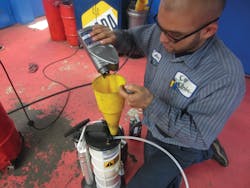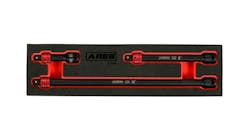Q: What kind of investment do I have to make to get into diesel service?
A: Here's the truth. The future of profitable automotive repair is going to be trucks. Have you noticed that dealer exhaust takes longer to rust, that dealer brake pads last over 50,000 miles and vehicles these days break less in general? As we speak they are releasing "lifetime rotors" for police vehicles that have a thin layer of steel on the outside that is hardened so that it will never wear. Vehicles are going electric where they will never need brakes, exhaust or anything that makes us money. The whole automotive landscape is going to be radically different in a single generation.
The money is going to be in vehicles that are too heavy or do too much commuting to be fully electric and the diesel engine already dominates this category, even in diesel-hating America.
The biggest investment you will need to make is in diesel training or an experienced diesel technician. Quite frankly, you do not need an intellectual knowledge of diesel mechanics to remove and replace parts on a diesel. However, you will need a diagnostician that is capable of understanding how a diesel works.
Q: I heard that to work on diesels, I don't need that many new tools. Is that true?
A: Yes, working on diesels does not require a great deal of different tooling. There are some tools that you probably don't have and might need. One may be an EGR cooler element pressure tester, because your regular pressure tester will not fit on it. You might have to get one from the dealer.
Many diesel fuel injectors go bad and create misfires, especially on Fords, and oftentimes you will need specialty tools to service these vehicles. (See Fig. 1.) If Mode 6 cannot tell you what cylinder has the misfire, a fuel injector tester that can fit the fuel injectors or test them indirectly (such a Strategic Tools' Diesel Injector Test Kit that measures unused diesel per injector by volume, see Fig. 2) might help as well. You may also need a special set of fittings to do diesel compression testing.
However, such tools are few and far between. Instead, you will need the right "normal" tools and the knowledge on how to use them.
You will need the right scan tools to work on these vehicles that are particularly strong in American trucks. If you want to make some suggestions, or need some, check out VehicleServicePros.com/10816382.
These scan tools need to be able to do certain bidirectionals (such as opening the EGR valve on new diesels) and read certain PIDs (Turbo Boost Sensor voltage, which is listed as a "MAP Sensor" on Dodge diesels) that some other aftermarket scan tools might not have, because they focus on more common vehicles. When looking at PIDs, watch out! Odd diesel parts (i.e. NOx Sensor) might be listed as something else, such as a HO2S on GM diesels. Your scan tool will also need to be able to do relearns/adaptations. For example, new Ford 6.7L diesels need each new fuel injector coded to the PCM in order for the engine to run right. Cummins diesels are the same way.
If you don't have a smoke machine, you will need one now. Air leaks are notorious for creating major driveability issues on diesels. For example, a 97 Chevy K3500 had a diesel fuel injection pump replaced because it had CMP codes, but it kept coming back with driveability problems. The root cause? An aftermarket fuel level sender unit that would quickly lose its seal. Whenever it was sent back to the parts store, the new one would quickly develop the same problem. Intake leaks can also cause their share of problems. The only way to catch this is with a smoke machine.
Many of the hand and shop tools used to repair diesels are exactly the same as the ones used on gasoline vehicles. Keep in mind the following: You might need a vacuum extractor in order to remove water from some diesels' water separators, but most can be drained simply turning a screw or knob. The primary and/or secondary fuel filters might come as filter elements instead of in a "can," so you will need a torque wrench to properly tighten the fuel filter housing. Just remember to prime the fuel pump (either by turning the key or using a scan tool) in order to get air out of the system after installing a new fuel filter. Diesels often need the same maintenance services that regular vehicles need. Coolant flushes, transmission fluid exchanges and etcetera.
If you are getting into passenger-car diesels, you are going to need to get acquainted with VWs. The way you would diagnose and service a VW diesel is not particularly special, but you will need a fluid extractor/installer to do a transmission service. Why? It has a single drain plug that acts also as a fill hole. As you can see in the picture, we made an adapter simply by drilling a hole through a matching drainplug, and snaking the fluid extractor's tube through it! (See Fig. 3, 4, 5, 6 and 7 on details how to do this.)
Q: What diesel-additives are necessary these days?
A: The popular additives these days are the anti-gels and fuel-lubricants. "Common knowledge" dictates that the ULSD fuel, with only 15 PPM of sulfur, lacks the sulfur necessary to properly lubricate a diesel engine and its components (fuel injectors, fuel pump, etcetera). While this may be true of older diesels, newer diesels are designed to work with the new fuel, so it is hard to endorse a lubricant as "necessary," though it might be helpful. As of yet, no real testing has been done to find out if the fuel additives in ULSD fuel is more than sufficient. Nonetheless, fuel additives from a mainstream company are not necessarily bad and they could be an added source of revenue for the shop.
Anti-gel additives are a different story. They are useful, but not necessary if you have winter blend gas in your area. Now, if you have one of those freakish deep freezes that your local area usually gets only once a decade or you parked your diesel for months with summer fuel, the anti-gel can be a great help.
Also consider the use of anti-microbal additives if the diesels you work on tend to have "slime" clog their fuel filters. Watch out not to confuse this with a dark slime typical of asphaltene (moisture related) contamination, which is treated with thermal and oxidation stability fuel additives.


